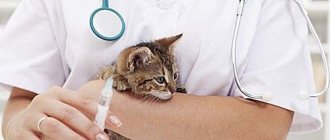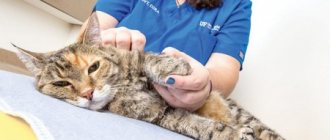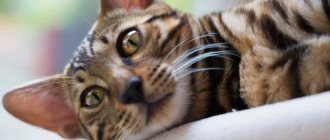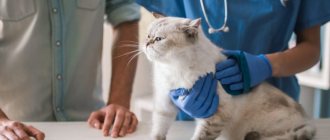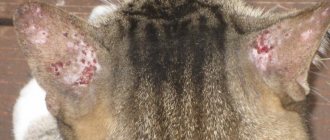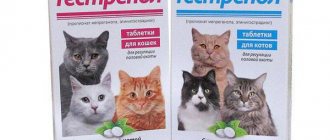A healthy cat can be easily distinguished by its active behavior, enviable appetite and shiny coat. But if one of the listed signs no longer corresponds to reality, it means that the pet has health problems. The symptoms of many diseases in cats often manifest themselves in the same way. In order to provide timely assistance to the animal, the owner must know the main signs of the most dangerous diseases.
Feline immunodeficiency virus
Feline immunodeficiency virus (FIV) is one of the most common retroviruses in nature. Simply put, it belongs to the same family as feline leukemia virus (FeLV) and human immunodeficiency virus. The pathogen attacks the immune system, as a result of which the body cannot resist infections or parasites. It is believed that about 3.5-4.7% of cats in our country are infected (according to the most optimistic data). Considering their total number, the figures are extremely impressive.
All retroviruses are species specific. This means that owners of sick cats can rest easy: it is impossible to become infected with immunodeficiency from their pet. In addition, like all viruses, the pathogen is not very stable in the external environment. Ordinary sunlight kills it in about 20 minutes, boiling it instantly, basic disinfectants kill it in three to five minutes.
How is feline immunodeficiency virus transmitted? Let us immediately note that airborne infection does not occur, so in case of accidental contact with other pets, your cat will not get sick. But a lot of the virus is released along with saliva, so that pathogens are transmitted from animal to animal through bites. Fortunately, there are very few officially confirmed cases of transmission through breast milk or intrauterine infection. In more than 90% of cases, sick cats give birth to completely healthy kittens. But! If a cat becomes infected while already pregnant, then her offspring will most likely be initially sick.
Clinical manifestations
Let's look at the symptoms. Let us immediately note that in many adult cats the infection does not manifest itself for the time being, but sooner or later the symptoms become obvious.
It all starts with lesions in the oral cavity. They occur in approximately 50% of cats with the immunodeficiency virus. It can be difficult to see ulcers or wounds in an animal’s mouth, but the pet develops very bad breath, he practically does not eat, and when trying to palpate the lower jaw, the cat reacts inappropriately. Note that standard treatment methods practically do not help; the ulcers heal very poorly.
Chronic respiratory infections are no less common It is believed that they occur in 30% of sick animals. As a rule, respiratory infections in these cases manifest themselves in the form of a chronic runny nose, and a thick, yellow-green exudate is released from the nostrils. It’s much worse that over time (due to complete degradation of the immune system), a simple runny nose can develop into severe bronchitis or pneumonia.
is also possible . They manifest themselves in the form of conjunctivitis; in more severe cases, keratitis is possible. Unfortunately, feline immunodeficiency can even lead to glaucoma.
In addition, the immunodeficiency virus leads to the development of diseases of the gastrointestinal tract . As a rule, such animals develop chronic diarrhea (up to 20% of all examined carriers of the infection). Among other things, the disease opens the door to parasitic infestations (since there is no immunity, nothing interferes with the larvae of worms), cancer, and other dangerous intestinal pathologies.
One of the first signs of immunodeficiency may be chronic otitis media and other damage to the hearing organs. This happens due to a drop in immune tension. Fungal and bacterial pathologies develop, as a result of which hair falls out on the ears and pus is released from the ear canals. The likelihood of tick-borne infections increases sharply. In addition, the development of large abscesses directly in the ear canals is possible.
Finally, sick cats often behave inappropriately , which is associated with the development of neurological pathologies (the virus can penetrate the blood-brain barrier). The pet loses the ability to learn and often does not recognize its owners or its surroundings. Today, researchers are arguing about what exactly causes such consequences: the actions of the virus itself or the “work” of pathogenic microflora that multiplies massively in the body of a sick animal.
Therapeutic techniques
Unfortunately, in veterinary medicine to this day there is not a single specific medicine that would be effective against the feline immunodeficiency virus. Some success has been achieved when drugs have been used against human variants of the retrovirus.
The only problem is that they are very toxic to the cat's body. Human interferon administered intranasally, autohemotherapy and aloe extract intramuscularly have proven themselves to be quite good. But all this is “amateur activity” of practicing veterinarians; there is no official approval of these methods yet.
How to calculate the required number of calories
REP - resting energy requirements (number of calories) a cat needs at rest for good metabolism is calculated using the formula.
30 cal x cat’s weight in kg +70 cal
Examples:
- Cat weight 5 kg – 30 x 5 + 70 = 220 - this is the cat’s PEP
- Kitten weight 1 kg – 30 x 1 kg + 70 = 100 – this is the kitten’s PEP
- A cat with emaciation of 3.5 kg - 30 x 3.5 + 70 = 175 - this is the cat's PEP
- Overweight cat 6.5 kg – 30 x 6.5 + 70 = 265 – this is the cat’s PEP
EPE - the daily energy requirements required by your cat depend on age and condition, summarized in a table.
| Kittens | — | PEP x 2.5 |
| Adult healthy cat | — | PEP x 1.2 |
| Unneutered cat | — | PEP x 1.4 |
| Overweight cat | — | PEP x 1 |
| Obese cat | — | PEP x 0.8 |
| Malnourished cat | — | PEP x 1.8 |
Calculation of EPE
- Cat weight 5 kg - 220 x 1.2 = 264 cal.
- Kitten weight 1 kg – 100 x 2.5 = 225 cal.
- Malnourished cat 3.5 – 175 x 1.8 = 315 cal
- Obese cat 6.5 – 265 x 0.8 = 251 cal
Naturally, if a cat loses weight, its EPI drops, which requires a recalculation of its EPI.
The same goes for kittens as their weight increases. Therefore, it is necessary to monitor your weight and calculate your EPE weekly. Pregnant and lactating cats are allowed to eat as much as they want to be healthy. During this period of life they require additional calories.
Feed your cat good quality, high-calorie foods and weigh her once a week to help regulate her weight.
( 4 ratings, average: 3.25 out of 5)
Feline infectious peritonitis
An extremely dangerous and almost always fatal viral infection of domestic and some wild animals. Thus, the disease affects pumas, lynxes, lions and cheetahs. It is interesting that in nature there are two types of this virus, and it is not always possible to distinguish them by “external” signs even in laboratory conditions (only in animals they act in radically opposite ways). One of them, although it develops in the body of predisposed animals, causes only “mild” clinical signs, and more often there are no manifestations of the disease at all (FECV). The virus that causes “classical” infectious peritonitis is designated FIPV. Why are these pathogens so similar? In fact, they are the same virus. It has been shown repeatedly that FECV can spontaneously mutate into FIPV. Why does this happen? The question is interesting, but there is no answer to it yet. No one has yet described cases of reverse “transformation”.
And that is why another problem arises. It is still unknown what the actual prevalence of the virus in nature is. At one time, research by Italian, Chinese and Russian veterinarians proved that the FECV coverage rate can reach 35-40% (at home), approaching 93% if we talk about nurseries and animal shelters. Today, experts are inclined to believe that at least 5% of sudden deaths of cats occur due to spontaneous mutations of the virus and its transition to a pathogenic state.
Clinical picture
"Dry" or non-expansive form. Occurs in approximately ¼ of affected cats. “Clinic” is growing slowly. The animal's appetite gradually worsens, it becomes lethargic, and the quality of its coat decreases. Neurological seizures occur in 10-25% of cases. Paralysis, disorientation, trembling and convulsions, involuntary release of urine and feces are possible. Sometimes the liver and kidneys fail. In some cases, the only sign indicating the presence of infection is eye lesions (conjunctivitis and keratitis). Note that eye diseases are a classic symptom of many viral infections.
"Wet" or expansive form. It flows much more severely, it turns on. Intermittent fever often develops. In more than 70% of cases, progressive anemia develops, and digestive problems also appear (in the form of intermittent cases of diarrhea and constipation). To make matters worse, infectious peritonitis in the expansive form almost always develops ascites (edema of the abdominal cavity), making the cat look like a pear. In about 27% of cases, hydrops of the chest cavity also develops (sometimes even simultaneously with ascites), which causes breathing problems. Unfortunately, about 83% of cats with this form of the disease die within two weeks of the first signs appearing.
What to do?
As in the previous case , there is no specific treatment. Therapy is symptomatic; human interferon is also used. Ascites is combated by promptly pumping out fluid from the abdominal cavity through a catheter, and simultaneously prescribing medications that support liver function. Anti-inflammatory corticosteroids and loading doses of antibiotics (to prevent secondary infections) are often prescribed.
As a rule, it is still not possible to completely destroy the virus, but it can be suppressed. Subsequently, “formally” cured animals must be examined by a veterinarian at least once a quarter.
Aspergillosis
A fungal infection common in cats of all ages and breeds. The further south you go, the higher the prevalence of the disease. Often the only symptom is a chronic runny nose. Diagnosing and treating the pathology is difficult (like all other fungal infections). The sooner the owner realizes that something is wrong with his cat, the greater the chance of a successful outcome.
Everything is complicated by the fact that the Aspergillus fungus is very widespread in the external environment. Despite this, not every animal or person who enters the body with fungal spores gets sick. In most cases, the infection develops in pets after a long course of antibiotic therapy or inappropriately long use of anti-inflammatory corticosteroids. Also, the practical experience of veterinarians around the world proves that aspergillosis very often becomes a secondary infection in all types of diabetes in cats. The symptoms of the disease are as follows:
- Thick exudate is released from the nostrils. At first it is yellow-green, then blood and scraps of dead tissue may appear.
- If you look closely, you can see ulcerative lesions on the inside of the nasal passages.
- The cat does not allow you to touch his face and, especially, his nose, since the slightest mechanical impact causes him severe pain.
The combination of these symptoms strongly suggests aspergillosis.
Therapy
The two most commonly used medications are itraconazole or fluconazole. Unfortunately, their oral administration rarely has an effectiveness of more than 70%. If the case is severe, only rinsing the affected nasal sinuses with the same drugs can help, and this requires first opening them during a rather difficult operation. Despite the complexity and high cost, this method is much preferable. Its effectiveness rates exceed 94% in some cases. Please note that not all cats tolerate this type of surgery well. Much more promising and safer is flushing the sinuses through a surgically implanted catheter. Efficiency rates reach 97-98%.
Calcivirosis and rhinotracheitis
Very common diseases of the respiratory system (and not only) . Why do we consider these pathologies together? They are both caused, as a rule, by calciviruses, but in practice there are often situations when several pathogens can “live” in a cat’s body at once. In addition, calcivirosis with infectious rhinotracheitis very often complement each other. Finally, their symptoms are quite similar, and therefore a specialist may make a mistake when making a diagnosis in a clinic. We will look at the differential features in the table below.
There is no specific treatment for any disease; therapy is purely symptomatic.
Symptoms
Obvious signs of the causes of weight loss are the cat's behavior: increased appetite or refusal to eat, activity, and the age of the cat.
- Polyphagia (increased appetite) or anorexia (loss of appetite)
- Cat's bad breath
- Increased thirst and urination
- Changes in feces (watery, greasy, foamy, diarrhea, black and tarry)
- Vomit
- Changes in coat condition
- Increase or decrease activity
- Poor wound healing
- Behavioral changes such as depression, inactivity, prolonged sleep.
Panleukopenia (feline distemper)
A very severe and extremely contagious disease of cats with a high mortality rate (especially in kittens). It is caused by a virus that tends to parasitize the epithelial cells of the digestive system, bone marrow and lymphoid tissues, and is also able to overcome the blood-brain barrier and penetrate directly into the brain. The only protection is timely vaccination; there are no effective drugs. The disease is called panleukopenia because the number of leukocytes in the blood of a sick animal decreases to critically low levels. Since these cells are responsible for forming the immune response, the animal often dies not even from the virus itself, but from secondary bacterial infections that easily infect a defenseless organism.
The symptoms are quite standard - first an intermittent fever develops, vomiting, diarrhea occurs, and neurological attacks may occur. In the fulminant form of the disease, the cat falls into a coma. When an unvaccinated kitten from an unvaccinated mother falls ill, it dies with a probability of more than 97%. In general, if a cat gets distemper during pregnancy , she will have a miscarriage. Interestingly, after this the pet’s condition improves sharply; the disease can go away within a few days.
The incubation period in “classical” cases lasts from three to five days. There are often cases when animals over the age of four years do not show any symptoms of the disease at all, suffering the pathology “on their feet.” But this is rare. As a rule, the cat abruptly refuses food, its body temperature rises to 40° Celsius.
Often everything happens so suddenly that owners are inclined to believe that their pet was simply poisoned. If the animal does not die on the first day (and this is quite possible), then after another couple of days severe dehydration will develop. The worst thing is when the brain is already damaged: the cat sees a bowl of water, can bend over it, but is unable to drink. Also, cats (especially young ones) may develop diarrhea with copious amounts of blood.
Viral diseases in cats. Survival percentage
Many owners who bought themselves a cute cat are surprised why one is a completely healthy cat, while the other is constantly sick and weak. It's all about the immune system, which is completely different in cats. In one, it is perfect and can even withstand life in a city dump, while in the other, it cannot even withstand the gaze of another pet. The owner’s task is to comprehensively strengthen the cat’s immune system . Contact your veterinarian to prescribe immunomodulatory drugs.
Leukemia
In this case, we are talking about leukemia, which is caused by the feline leukemia virus (often referred to as FeLV). The disease is extremely dangerous, with a high mortality rate. In addition to leukemia itself, the virus contributes to the development of other forms of cancer. Moreover, symptoms can develop over many months or even years from the moment of infection. It is believed that about 2.3% of cats in our country are carriers. The pathogen is transmitted through food, water, and care items. Infection is possible through the bites of other animals. The clinical picture is extremely varied:
- Weight loss.
- Intermittent fever.
- Autoimmune pathologies.
- Chronic anemia.
- Reproductive problems, including abortion and infertility.
- Gastrointestinal disorders.
- Neurological seizures.
- A decrease in the number of platelets and, as a result, a serious deterioration in blood clotting.
- Lymphadenopathy (enlarged lymph nodes).
- Neoplasms.
- Cough, bronchitis and pneumonia.
- Ulcerative lesions of the oral cavity.
The worst thing is that the disease leads to a decrease in the body's immune reactivity , which always results in increased susceptibility to bacterial, fungal, protozoal, and viral infections. In particular, feline infectious peritonitis (which was already mentioned above) is often paired with leukemia. But the first sign indicating a possible infection is chronic pathologies of the oral cavity. In addition, reproductive problems in sick cats are considered a “classic”. When cats become infected, they abort in more than 83% of cases; even in the case of “normal” births, dead kittens are born or the litter has some defects. Sick or recovered cats often become infertile.
Leukemia is treated with chemotherapy , which includes a combination of cytotoxic drugs and prednisolone. Unfortunately, therapy does not always allow you to completely get rid of the disease.
Treatment
Treatment should address the underlying cause of the disorder (if any), as well as nutritional support, which may include appetite stimulants or a feeding tube for an anorexic cat, and other possible causes.
Systemic diseases
Renal failure - low protein diet, phosphorus binders, saline solution to treat dehydration.
Addison's disease is a lifelong replacement of missing adrenal hormones.
Hyperthyroidism - radioactive iodine to stop tumor growth or surgical method (tumor removal).
Hypertrophic cardiomyopathy —Treatment is aimed at relieving symptoms, including beta blockers to help with heart muscle contraction, blood viscosity, and activity limitation.
Diabetes - switching to a low protein diet. If dietary management fails to control the condition, then treatment with insulin injections is required.
Pancreatitis - maintenance therapy, antitumor drugs, use of antibiotics for infection.
Exocrine pancreatic insufficiency - pancreatic enzyme extract, high protein diet. Antibiotics are sometimes prescribed to treat a bacterial infection in the small intestine.
Liver disease – diet and nutritional support, herbal infusions, anti-nausea medications, in some cases corticosteroids.
Inflammatory bowel - a strict diet to ensure good digestion of food, corticosteroids to reduce inflammation, immunosuppressants, sometimes antibiotics are prescribed.
Glomerulonephritis - diuretics to remove excess fluid, high protein diet, drugs to treat high blood pressure, steroids to reduce inflammation.
Cancer - Treatment will depend on the type of cancer and metastasis. The radical treatment method is surgery (tumor removal). Chemotherapy or radiation therapy is also used.
Infections and parasites
Infections
Antibiotics are used to treat a bacterial infection. Supportive care is also required to treat dehydration as well as nutritional support.
Medicines are used to treat helminths and it is recommended to follow safety precautions regarding maintenance and infection.
Feline leukemia virus (FIV and FeLV)
Incurable, support is offered which consists of maintaining a stress-free living environment for the cat. Antibiotics are used to treat infections that are likely to occur with this diagnosis. A high-quality diet, good housing and regular veterinary checkups can prolong a cat's life.
Parasitic worms
Medicines are used to treat helminths and it is recommended to follow safety precautions regarding maintenance and infection.
Hookworms heartworm is difficult to cure. In mild cases, it is possible to use an adult to kill heartworms, but this treatment method carries high risks.
Other treatments
Pregnancy and lactation
Pregnant and lactating cats need to increase their diet.
Diet
In order to meet your cat's nutritional needs, it is necessary to provide it with a balanced diet of good quality foods. If there are several animals, if necessary (for example, if one animal is dominant), feed from separate bowls and/or in different places
Stress
Determine the cause of stress and reduce it. If you have several animals, provide each of them with their own place to eat and rest. Eliminate and regulate conflicts between them, devote time to them, play.
Rabies
The disease is known, although in veterinary practice it is rarely encountered (much to the happiness of doctors). The pathology is caused by a virus. After the first symptoms appear, therapy is impossible, the animal is doomed. Transmission of the pathogen occurs through the bites of sick animals. Since the virus spreads along the nerve trunks towards the brain, the location of the bite directly affects the likelihood of survival. The closer it is to the head, the lower your cat's chances. In addition, cats are small creatures, and therefore the pathogen moves faster along their nerve trunks. So in most cases, the first clinical signs develop within three to five days from the moment of the bite. The only reliable means of prevention is vaccination (which many owners neglect).
Attention! If you see any clinical signs in your pet, at least similar to those described by us, immediately isolate the cat in a separate room and call a veterinarian! Rabies is an incurable and deadly disease for humans. There is no need to forget about this.
The “clinic” depends on the immediate form of the pathology, of which there are two: violent and quiet. In the first case, the cat becomes extremely aggressive and attacks all people and other animals. Please note that all this happens in complete silence; the rabid pet does not make a sound. He begins to be terrified of water and eat inedible objects (even to the point of swallowing sawdust and pieces of brick). In a quiet form, everything looks much more harmless. The cat, even if in the recent past was very aggressive and “characteristic,” becomes very affectionate. Saliva in such animals, as a rule, is also secreted, albeit in smaller volumes. Cats infected with a silent form of rabies easily “gain trust” in people and bite them. Often a person finds out about his illness only when nothing can be done to help him. Just like a sick cat, by the way. All rabid animals are euthanized and their bodies are disposed of by burning.
What pathologies are older cats susceptible to?
Cats age suddenly. This happens at 8-10 or 12-15 years. During this period, owners treat their pets with care.
Behavior of an old animal:
- sleeps a lot, doesn't play;
- He hears and sees poorly, does not smell;
- the fur is peeling off and does not shine;
- Nervousness and fearfulness appear.
The owners take care of the fur and trim the claws. They feed them a balanced diet and give them vitamins. The tray and house are placed in an accessible place. They visit the veterinarian often and give the kitty all the love they can.
Cats have accompanied humans throughout the history of civilization. This is an old friend who deserves attention and respect. Cats get sick too. And people treat and care for them. The list of cat ailments is long. All diseases have been studied, there are ways to treat them. You just need to pay close attention to the animal’s behavior, vaccinate it on time, and show it to the veterinarian.
Tuberculosis
The disease is well-known and is considered “social”, as it is widespread in countries with a low standard of living and poor quality medicine. Easily transmitted from animals to humans and vice versa. Of course, it is theoretically believed that each animal species has its own specific type of pathogen, but the microbe does not pay attention to such “conventions,” so there is always a risk of infection. Fortunately, cats suffer from tuberculosis extremely rarely (but still cases are far from isolated).
The first sign of the disease is swollen submandibular lymph nodes. When the pathogen in them is sufficiently mature, it quickly spreads throughout the body. Most often, tubercles form in the lungs, causing the cat to cough. When pregnant cats become infected with tuberculosis, miscarriages occur, and cats often become infertile. In addition, tuberculosis in animals often manifests itself in the form of arthritis and arthrosis. The owner should immediately be alerted to problems with the legs of a still young pet.
If you think your pet may have tuberculosis, notify your veterinarian immediately and be sure to isolate your cat from people and other animals! Please note that tubercle is an extremely resistant bacterium in the external environment, and therefore, to disinfect the premises in which a sick cat was kept, powerful disinfectants must be used in maximum concentrations.
